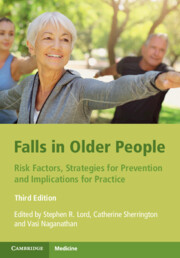Book contents
- Falls in Older People
- Falls in Older People
- Copyright page
- Contents
- Preface
- Contributors
- Part I Epidemiology and Risk Factors for Falls
- Part II Strategies for Prevention
- Part III Implications for Practice
- 28 Strategies to Promote Uptake and Adherence to Fall Prevention Programmes
- 29 Translating Fall Prevention Research into Practice
- 30 Interventions Reduce Falls, but What Is the Cost for Better Health Outcomes?
- 31 Bringing It All Together
- Index
- References
31 - Bringing It All Together
from Part III - Implications for Practice
Published online by Cambridge University Press: 04 November 2021
- Falls in Older People
- Falls in Older People
- Copyright page
- Contents
- Preface
- Contributors
- Part I Epidemiology and Risk Factors for Falls
- Part II Strategies for Prevention
- Part III Implications for Practice
- 28 Strategies to Promote Uptake and Adherence to Fall Prevention Programmes
- 29 Translating Fall Prevention Research into Practice
- 30 Interventions Reduce Falls, but What Is the Cost for Better Health Outcomes?
- 31 Bringing It All Together
- Index
- References
Summary
The vast amount of literature on the many risk factors for falls and the various intervention options can make interpretation and implementation of the evidence difficult. This chapter overviews the research findings presented in previous chapters to assist the reader to integrate this information and use it to guide their own research and/or practice. It concludes with a brief review of select research issues that need to be addressed in the future.
- Type
- Chapter
- Information
- Falls in Older PeopleRisk Factors, Strategies for Prevention and Implications for Practice, pp. 469 - 480Publisher: Cambridge University PressPrint publication year: 2021



